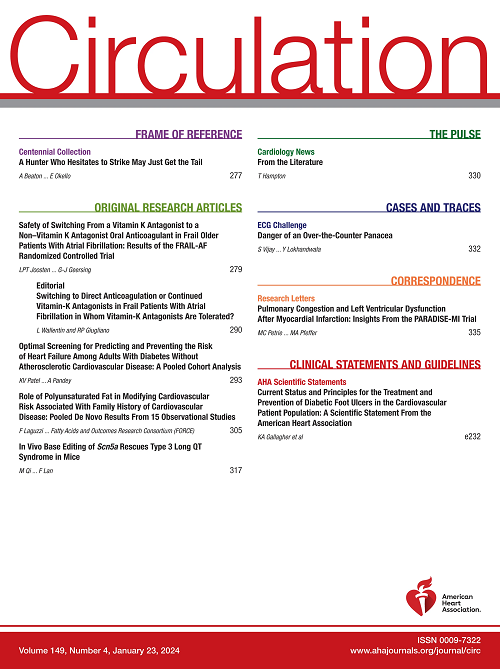Partnership Model of Regionalized Care for Congenital Heart Disease in Resource-Limited Settings: Results From the ASSIST Project.
IF 38.6
1区 医学
Q1 CARDIAC & CARDIOVASCULAR SYSTEMS
引用次数: 0
Abstract
BACKGROUND Equal access to care for patients with congenital heart disease (CHD) remains unrealized globally. The ASSIST project (Academic Medical Hospitals-Local Institutions collaboration) is an ongoing national quality initiative implemented in low-resource settings in China attempting to reduce gaps in access to CHD care. This study sought to evaluate its feasibility and effectiveness. METHODS Shanghai Children's Medical Center, an academic medical center, has partnered with 4 local hospitals in low-resource regions to enhance local CHD programs since 2021. Comparison was made between patients receiving treatments in these 4 local hospitals before (2013-2020) versus after the ASSIST project (2021-2024). In addition, contemporaneous patients receiving treatments in Shanghai Children's Medical Center (2021-2024) were compared with the post-ASSIST cohort of patients. The primary outcome was a composite of postoperative mortality and multiorgan dysfunction. A key secondary outcome was delayed treatment, defined as an interval of more than 6 months between the time of surgery and the time when the clinicians recommended surgery at the initial presentation. RESULTS The analysis cohort included 11 895 pediatric patients (median age, 2.0 years [25th-75th percentile 0.7-5.0]; 5933 female [49.9%]), with 3333 cases in the pre-ASSIST group, 1566 in the post-ASSIST group, and 6996 in the Shanghai Children's Medical Center group. Lower family educational attainment (odds ratio, 1.50 [95% CI 1.21-1.85]; P<0.001) and lower annual household income (odds ratio, 1.65 [95% CI, 1.14-2.38]; P=0.008) were associated with increased incidence of the primary outcome in the low-resource regions but could be mitigated by the ASSIST project in a multivariable model. There was a change in case mix of the CHDs after the ASSIST project, with a significant increase in more complex cases (35.5% versus 7.3%; P<0.001) and neonatal surgery (9.1% versus 1.5%; P<0.001). A higher portion of patients in the pre-ASSIST group had delayed treatment compared with those in the post-ASSIST group (43.2% versus 23.3%; P<0.001). Primary outcome analyses showed that patients in the post-ASSIST group and the Shanghai Children's Medical Center group had equivalent outcomes (4.4% versus 3.6%; P=0.13). CONCLUSIONS Interhospital partnership appears to be a useful and feasible method to deliver regionalized quality care for pediatric patients with CHD in resource-limited regions.资源有限地区先天性心脏病区域化护理的伙伴关系模式:来自ASSIST项目的结果。
在全球范围内,先天性心脏病(CHD)患者获得护理的平等机会仍未实现。ASSIST项目(学术医疗医院-地方机构合作)是在中国低资源环境中实施的一项正在进行的国家质量倡议,旨在缩小冠心病治疗的可及性差距。本研究旨在评估其可行性和有效性。方法自2021年起,学术性医疗中心上海儿童医学中心与资源匮乏地区的4家当地医院合作,加强当地的冠心病项目。比较ASSIST项目实施前(2013-2020年)与实施后(2021-2024年)在这4家地方医院接受治疗的患者。此外,将同期在上海儿童医疗中心接受治疗的患者(2021-2024)与assist后队列患者进行比较。主要结局是术后死亡率和多器官功能障碍的综合结果。一个关键的次要结局是延迟治疗,定义为手术时间和临床医生建议手术时间之间的间隔超过6个月。结果分析队列包括11895例儿童患者(中位年龄2.0岁[25 -75百分位0.7-5.0];女性5933例(49.9%),其中assist前组3333例,assist后组1566例,上海儿童医疗中心组6996例。较低的家庭受教育程度(优势比,1.50 [95% CI 1.21-1.85];P<0.001)和较低的家庭年收入(优势比1.65 [95% CI, 1.14-2.38];P=0.008)与低资源地区主要结局发生率增加相关,但可以通过ASSIST项目在多变量模型中减轻。ASSIST项目后,冠心病的病例组合发生了变化,更复杂的病例显著增加(35.5%比7.3%;P<0.001)和新生儿手术(9.1%对1.5%;P < 0.001)。与assist后组相比,assist前组患者延迟治疗的比例更高(43.2%对23.3%;P < 0.001)。主要结局分析显示,assist后组和上海儿童医疗中心组患者的结局相当(4.4%对3.6%;P = 0.13)。结论医院合作是资源有限地区为儿科冠心病患者提供区域化优质护理的一种有效可行的方法。
本文章由计算机程序翻译,如有差异,请以英文原文为准。
求助全文
约1分钟内获得全文
求助全文
来源期刊

Circulation
医学-外周血管病
CiteScore
45.70
自引率
2.10%
发文量
1473
审稿时长
2 months
期刊介绍:
Circulation is a platform that publishes a diverse range of content related to cardiovascular health and disease. This includes original research manuscripts, review articles, and other contributions spanning observational studies, clinical trials, epidemiology, health services, outcomes studies, and advancements in basic and translational research. The journal serves as a vital resource for professionals and researchers in the field of cardiovascular health, providing a comprehensive platform for disseminating knowledge and fostering advancements in the understanding and management of cardiovascular issues.
 求助内容:
求助内容: 应助结果提醒方式:
应助结果提醒方式:


